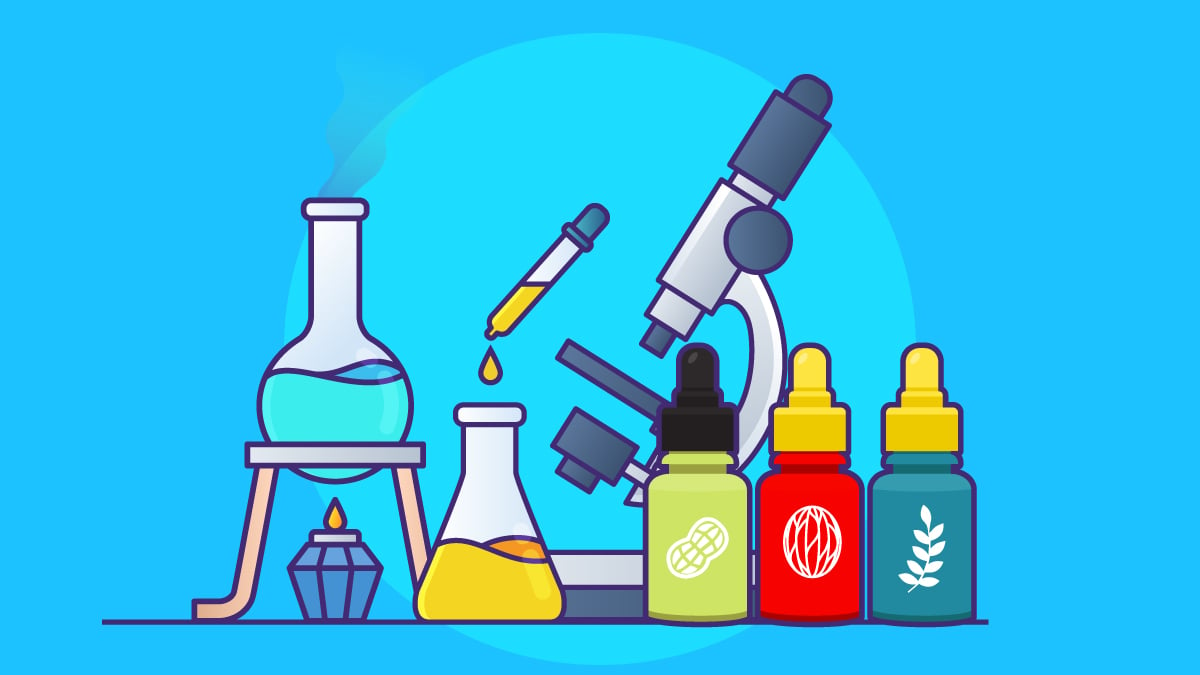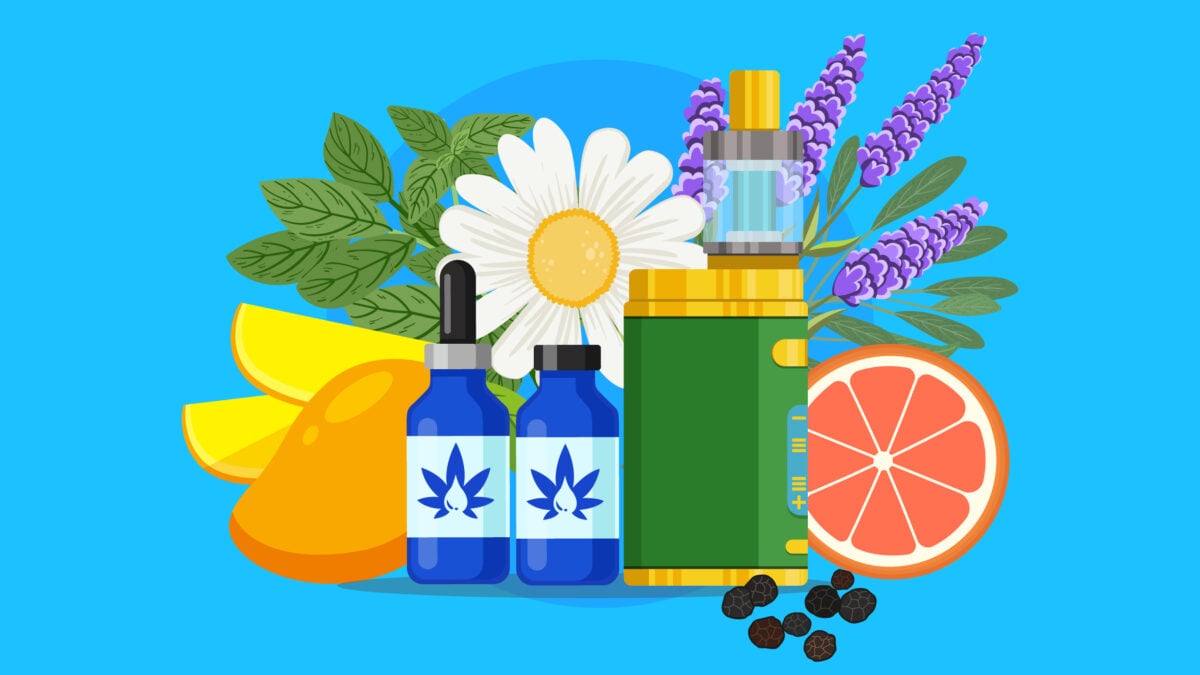Adding Terpenes to Cannabis Products (Distillate, Buds, Dabs, Oil, & Tinctures)

We all know that certain cannabis strains have a more pleasant scent, while others may be more pungent.
The compounds responsible for these unique scents are the terpenes — a class of volatile, synergistic hydrocarbons abundant in the plant kingdom.
By concentrating on these terpenes, we can use them to reinvigorate cannabis extracts, oils, and raw hemp buds to give it an improved flavor and even influences its effect profile. Here’s how it works.
What Are Terpenes?
As highly aromatic organic compounds, terpenes are actually the stuff we smell in plants and what gives them their characteristic scents. Whenever we get a whiff of a freshly peeled orange or the pine growing just beside our window, for instance, the fragrance we detect is actually a combination of terpenes of a particular plant.
Today, however, we mostly discuss terpenes when talking about cannabis because this plant has rather high concentrations of them. Besides that, science and research have helped us manipulate the compounds so well that we can add them to cannabis products for a quick boost or enhancement.
What’s important to know is that terpenes, which are secreted in the same glands as CBD and THC, give each cannabis strain a distinctive scent. Their development, though, doesn’t have much to do with making the plants smell nice; their primary purpose is to ward off predators and entice pollinators.
Either way, we can recognize a few major scents, which go from relaxing and soothing up to extremely energizing. The development of terpenes in a plant largely depends on environmental factors, such as the type of soil it’s growing in, the climate, the weather, how mature or old it is, etc.
The Most Common Terpenes & Their Effects
Apart from giving plants, including cannabis, a more enticing scent, terpenes may also have various effects on our bodies. As mentioned, some of them may be more energizing, giving us a spring in our step. Others, however, may enhance the already soothing effects of cannabis and send us into a deep relaxation mode.
Science has already identified over 100 terpenes in the cannabis plant, but six are famous for being extraordinarily fragrant and popular. They aren’t anything new, by any means, as these fragrances are evident in other plants that we have certainly sniffed at least once in our lives. Still, it’s good to know what their potential benefits are and why you may consider adding them to dabs, distillates, or buds:
1. Myrcene
Also found in thyme, mango, cardamom, ylang-ylang, citrus, bay leaves, and lemongrass.
As a herbal aroma that has hints of citrus, cloves, and musk as well, myrcene is the ideal terpene if we’re looking to relax after a hard day’s work. This particular terpene enhances the cognitive effects of THC, which bodes well with those who aren’t afraid of stronger effects.
2. Caryophyllene
Also found in pepper, cinnamon, cloves, oregano, hops, and basil.
As one of the spicier terpenes, caryophyllene may have an invigorating effect on the user. However, it’s often used to actually reduce the effects of some stronger cannabis strains.
3. Pinene
Also found in rosemary, basil, parsley, sage, pine needles, and conifers.
With a sharp yet sweet pine scent, pinene is the terpene we need if we’re looking to increase our focus and alertness. Out of these six most common terpenes, this one is the best choice if we need to “broaden our minds.”
4. Linalool
Also found in citrus, laurel, birch, lavender, sweet basil, and rosewood.
As you can imagine, linalool has a distinct floral scent with just a bit of citrus and spice added to it. As such, it’s likely to have a calming effect on the user.
5. Humulene
Also found in hops, sage, ginseng, and coriander.
For a more woody, earthy scent, there’s humulene, a terpene that may help suppress hunger levels.
6. Limonene
Also found in juniper, peppermint, and citrus (lemon, lime, grapefruit, orange)
With a distinct citrus-like scent, limonene makes you reminisce of freshly squeezed lemons and ripe oranges. It may very well elevate our mood in just a few whiffs.
The Benefits of Adding Terpenes to Our Cannabis Products
Improved Taste
Obviously, a major reason to add some terpenes to our cannabis is the flavor. Though some people enjoy the harshness of some strains, the flavors can be overwhelming and leave a bad taste in one’s mouth.
With some delicious terpenes, however, every cannabis session may be all the more pleasant. If you’re a huge lemon fan, for instance, or you enjoy a more earthy smoke, some terpenes may give you that extra kick. If they also match your desired results, there’s no doubt you’ll enjoy your cannabis more.
Entourage Effect
We still haven’t figured out all the effects terpenes can have on our bodies. Nevertheless, we know enough to want to add them to our cannabis. One of the reasons for this is that they can give us an entourage effect; they can enhance our uptake of cannabinoids.
Caryophyllene, for instance, can interact with CB2 receptors directly, whereas limonene may help the body absorb other terpenes better. The end result of all of this is a more complex and enhanced effect, one that wouldn’t be as strong if terpenes were excluded from the equation.
In layman’s terms, this means that terpenes can change the effect of two different strains even though they may have the same concentration of THC, for instance. Though the cannabinoid ratios are important when it comes to the effects, it’s the terpenes that may “sway the decision” and make a strain more relaxing or energizing.
In a nutshell, terpenes can change the effect profile of a certain cannabis product. At the same time, they can complement the effects of major cannabinoids, allowing users to experience more benefits with each session.
Revitalizing Dry Cannabis
Fresh weed hits differently, that much is true, but sometimes, we will have some leftovers that we won’t be able to use right away. If they get all dry and lose their aroma after a while, there’s no need to throw them away; we can simply add terpenes to revitalize the weed and basically give it a second life.
Granted, we shouldn’t expect miracles, as cannabis won’t probably get its original potency back. However, by adding a bit of moisture in the form of terpenes, we’ll give it a better taste and scent. At the very least, the addition of a few drops of our favorite terpene should make cannabis less harsh and easier to consume.
How to Add Terpenes to Enhance Our Cannabis Experience
Adding Terpenes to Hemp Buds
In case we have some dry buds and would like to enhance their effect with some terpenes, we must remember not to go overboard. Terpenes are definitely highly concentrated, so a little — very little! — goes a long way. Still, the process will depend on your preferences and desired effects.
There are a few ways we can use terpenes with buds. As mentioned, we can always moisten some dry buds by adding 1–2 drops of the oil per gram of flower. Alternatively, we could lightly coat our pipe bowl with it — about 0.2 mm should be enough.
In case we’re using a grinder, we can add a bit of the oil first (or oil the grinder lightly), then grind the bud and smoke or vape it.
The most common practice is to apply the terpenes to the flower itself. It’s certainly the easiest method to use! However, keep in mind that you really do need just a couple of drops. It may not sound like much, but it will be more than enough due to the concentration. If you add too much, the terpenes may overpower the taste and smell of the buds!
Adding Terpenes to Distillate
Cannabis distillates, which usually have a very high THC potency, are made with the use of a solvent. Yet, during that process, terpenes are boiled off and lost. That means the manufacturers have to supplement them afterward to ensure the content, strength, and effects are all up to standard.
Of course, some have figured out how to prevent this loss, while others embrace it and rebuild their extracts. What matters is that we can delve into making our very own designer cannabis products by getting our hands on some cannabis distillate and making our own blend at home.
The process is relatively simple. First, we have to choose the isolated terpene or terpene profile that we’d love to try and get a glass jar. After pouring the distillate into the jar, we should add one to two drops of terpenes per gram of oil. Before letting the mixture infuse overnight, we have to stir it well. For that, we can either use a dabber or a magnetic stirrer.
Adding Terpenes to Dabs (Cannabis Concentrates)
As a catch-all term for cannabis concentrates, dabs are fairly popular in the community, with dabbing being a fan-favorite way of consuming marijuana. In a nutshell, they are solvent-extracted doses of cannabis that take the form of sticky oils. When consuming them, we usually heat them on a hot surface (a nail, for instance) and then inhale through a dab rig.
The most common concentrates include shatter and butane hash oil, though many users also like budder. Some forms aren’t limited to dabbing only, like crumble, which we can sprinkle over our buds in a joint, blunt, or bowl, for instance.
Either way, when using concentrates (CO2 oil, crumble, budder, live resin, etc.), we should add only 1–5% of the total weight in terpenes. A good rule of thumb is to start with 2% and add more terpenes if necessary. Keep in mind that thicker (sappier) consistencies may require more, to begin with.
Shatter
Shatter is a rather potent concentrate as it goes through an additional filtration process to remove waxes and oils. Sadly, this means the terpenes get filtered out too, but we can replace them by adding about 0.02 grams per gram of shatter.
Remember to add the terpenes before the shatter dries. Alternatively, you can add some to a piece of shatter before vaping it. In that case, though, dosing the dab would be fairly challenging.
BHO & Rosin
Butane hash oil, however, requires a different approach. We would first have to pour it into a glass jar or on a silicone mat and then add 1–3 drops of terpenes. After mixing, or rather, folding and stirring, with a glass or metal tool (or a magnetic stirrer) until the mixture is homogeneous, we should be able to see whether the taste and the smell are just how we like them. If they aren’t, we can keep adding more drops until we get the desired results.
Once we’re done, we have to let the mixture sit for about 24 hours. By letting it rest, we will give the terpenes a chance to infuse themselves into the oil. The consistency should remain pretty even throughout. For best results, we ought to cover the mixture with some plastic wrap or a lid.
The same steps can be used when adding terpenes to rosin, for instance. Add one drop per 1–2 grams of rosin and mix well with a dabber or a scrapper. Then, hermetically seal the mixture and leave it to sit for 24 hours (at least).
Adding Terpenes to Oils
Finally, we can add some terpenes to promote the specific effects of our CBD or THC oils as well. In that case, however, we should follow the 2% rule or add 0.2 mm per gram of our oil. Using a syringe or a dropper while adding terpenes would allow us to be more precise. Alternatively, we can add some terpene isolate to each dosage (especially when taking CBD oil).
As always, it’s best to start slowly here as well, so we shouldn’t pour 2% right away. We can start with 1% first and see how we react to the added terpenes. If the results aren’t that different, we can always add more.
Final Thoughts
Evidently, adding terpenes to our cannabis products may not require much skill. However, it does mean we have to be patient enough to try and test the effects each time. The lowest amounts of terpenes may not fit each user out there, and some adjustments will have to be made.
Fortunately, you now know how to work with them and how much you usually need to add to buds, distillates, and dabs. From here on out, you can experiment and mix in your favorite terpenes for a unique flavor and aroma!




